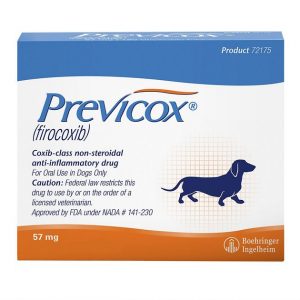Firocoxib is often available in brand names🙁 Previcox®) as a non-steroidal anti-inflammatory product used to treat pain and inflammation in dogs.
It is most frequently used for the treatment of arthritis and pain after surgery or trauma. Previcox is specifically created for dogs’.
-
Product on sale
 Firocoxib (Previcox) Chewable Tablets for Osteoarthritis in Dogs, 57 mg- 30 CountOriginal price was: $149.00.$135.00Current price is: $135.00.
Firocoxib (Previcox) Chewable Tablets for Osteoarthritis in Dogs, 57 mg- 30 CountOriginal price was: $149.00.$135.00Current price is: $135.00.
So what is Arthritis in Dogs?
Just like humans, dogs also suffer pain in their joints, and their walks become shortened and more painful.
This happens as a result of the degeneration of cartilage in their joints especially as they age. And when this happens to your dog, it causes inflammation and pain and can severely affect its joints mobility and general health.
This means your pooch will begin to experience difficulty in walking or a condition known as knuckling.
What are the specific causes of Arthritis in Dogs?
The various reasons your dog could be suffering from an inflammation due to arthritis. Such as;
- An infection.
- A hit or blow.
- Genetic causes
- And degenerative arthritis (Osteoarthritis) in older dogs.
And as mentioned earlier, your dog may get weaker on the legs as it ages.
Don’t worry, this is a common thing with senior dogs and is a kind of arthritis called Osteoarthritis.
Here are some things you need to know about Osteoarthritis?
This condition is commonly seen in many older dogs but it can develop earlier in some cases.
It occurs as a result of the gradual breakdown of the cartilage in dogs joints, causing it pain and inflammation in the joints.
Besides age injury, and repetitive stress can worsen this condition. So you are to make sure that you do not stress your dog especially if your pooch is already showing some symptoms.
The best thing to do in such a case is, shorten walks, and avoid giving your dog hectic tasks such as; running, jumping, climbing stairs, and dog racing.
Sadly arthritis cannot be completely cured but you can help in slowing down its progression by identifying the problem early.
So you should be very observant of your pooch to notice even the slightest change in behavior at the early stages.
How to know if your Pooch is suffering from Arthritis?
Your furry friend can’t speak. So, it is your duty as a dog parent to look out for the following signs;
- Loss of mobility and flexibility.
- Difficulty climbing stairs, sofa, or bed.
- Difficulty jumping.
- Stiffness after sleep.
- Becoming less alert and less responsive.
Note that arthritis may end up causing deformity in very advanced stages.
Also, like all diseases, arthritis can be mild, and can also get very severe. Plus, it can also be a terminal issue for larger dog breeds because they lose muscle mass and then they become weaker, then lose their ability to walk.
Hopefully, you can keep a close watch on your dog to be able to identify arthritis as early as possible.
But keep in mind that most of the symptoms can also be attributed to other diseases. So you should always seek veterinary help when you notice these signs.
Your dog’s loss of mobility might worsen over time if left completely ignored.
Recommended Treatment
Now, to manage your dog’s arthritis, Firocoxib is a licensed product you can use. But please allow your vet to examine your dog and prescribe the appropriate medication.
So let’s talk more about this product.
Continue to the end of this article to find out.
- What is Firocoxib (Previcox)?
- How does Firocoxib (Previcox) work?
- How to administer Firocoxib (Previcox)
- Required Dosage of Firocoxib (Previcox)
- What are the Side effects of Firocoxib (Previcox)?
- Signs that Previcox might be toxic to your dog
- Interactions
- Storage
- Other ways you can assist your dog who’s suffering from arthritis
- Conclusion
What is Firocoxib (Previcox)?
This is an FDA approved non-steroidal anti-inflammatory drug (NSAID) pronounced (N- said) mostly used for the alleviation of arthritis pain in dogs.
This drug is available in form of chewable tablets and it is said to give a strong and fast relief to your pet from the pain and inflammation caused by arthritis.
Before giving any medication to your pets ensure to first consult your vet to know if the medication is suitable for your dog, and only administer after your vet gives a prescription.
How does Firocoxib (Previcox) work?
This drug works by releasing the cox-2-cyclooxygenase-2 enzyme responsible for the production of chemicals responsible for pain inflammation and fever in your dog’s body.
It is said to start working against inflammation within 1 to 2 hours of ingesting the dose and due to it’s quick span of action, or is regarded as a first-choice arthritis medication by many vets and dog parents.
How to administer Firocoxib (Previcox)
This product should be given only as prescribed by your vet.
Firocoxib (Previcox) comes in the form of chewable tablets and you can administer this drug to your pet with or without food.
Also ensure to inform your veterinarian if your pet is already on other medications to prevent any drug reaction complications.
Also, if you miss a dose, give the dose to your dog when you remember.
But if it is close to the next dose, skip it and give your dog only the next dose. Never combine two doses at once as this could lead to overdosing.
Remember, do not overdose your pooch as this can lead to severe health issues!
Required Dosage of Firocoxib (Previcox)
The recommended dosage of previcox is 2.27 milligrams per pound (5.0mg per kilogram) body weight daily for osteoarthritis.
Previcox is also used for the relief of postoperative pain and inflammation which is associated with soft tissue and surgery.
In this case, the recommended dosage is 2.27 milligrams per pound (5.0mg per kilogram) body weight for three (3) days.
The dose of previcox varies for the different stages of pain and inflammation. So ensure to follow the prescribed dose by your veterinarian before administering to your pooch.
What are the Side effects of Firocoxib (Previcox)?
Most of the side effects of this drug are mostly as a result of overdose, or its use with other medications hereby triggering a negative drug reaction that could be fatal.
The possible side effects include;
- Vomiting and diarrhea.
- Lack of appetite.
- Increased thirst and urination.
- Lethargy and seizure.
- Kidney and liver illness.
Signs that Previcox might be toxic to your dog
It has been known that some dogs develop allergic reactions to this medication.
Below are some signs that indicate Previcox might be toxic to pet.
So in case you notice any any of the following adverse reactions after giving this medication to your dog, please contact your vet immediately;
- Allergic reaction.
- Abdominal pain.
- Tenderness or discomfort.
- Bloody black stools.
- Skin rash and itching.
- Yellowing of the eyes.
- Unusual bruising and bleeding.
Interactions
Firocoxib (Previcox) should not be given with other NSAIDs or corticosteroids (e.g. prednisone, cortisone, dexamethasone or triamcinolone).
Precautions
The following should serve as a guide towards using Firocoxib (Previcox) for your dog;
- Firocoxib (Previcox) is for use in dogs only and should never be given to dogs that are hypersensitive to NSAIDs.
- This drug should also never be given with any other NSAIDs, including: Carprofen (Rimadyl), Meloxicam (Metacam), Etodolac (Etogesic), Deracoxib (Deramaxx), Aspirin.
- Also, don’t use this medication on your pooch if your dog weighs less than 12.5 pounds.
- Dogs that are dehydrated, on concomitant diuretic therapy, or those with existing renal, cardiovascular, and/or hepatic dysfunction are at a greater risk for experiencing adverse events.
- Note that the use of this drug for pregnant or lactating dogs has not been evaluated.
- Firocoxib (Previcox) should only be used for dogs aged 7 weeks or older – Use of Firocoxib (Previcox) at doses above the recommended dose in puppies less than seven weeks of age has been associated with serious adverse reactions, including death.
- This medication cannot accurately be dosed for dogs less than 12.5 lbs. in body weight.
- Report any suspected case of an overdose to your veterinarian.
- In case this medication is ingested by a human, please seek medical help immediately.
Storage
This drug should be stored at room temperature, between 59 and 86 Degrees Fahrenheit. And for brief periods at up to 104 Degrees Fahrenheit.
Ensure to keep out of reach of pets and children.
Other ways you can assist your dog who’s suffering from Arthritis
It is wonderful how some simple changes in how you manage your pet’s lifestyle could make a major difference with how happy and comfortable it gets to be.
Change your dog’s diet
As a dog parent, it is advisable that you cut back on foods that cause additional weight gain to your dog. Rather, a 6% weight loss can bring about some good improvement in your dog’s general health.
Obesity is a huge problem, and has a massive impact on comfort in arthritic pets. And you obviously do not want to stress out those already weak joints of your dog and further put your fur baby through extra pain for being overweight.
Nutrition (Joint Specific Diet)
You should feed your pet a good quality age-appropriate diet that contains a number of different things that helps it;
- Lose weight.
- Gain and maintain muscle mass.
- And also contains Omega-3 fatty acids that have an anti-inflammatory effect which helps improve your dog’s comfort and general health – Include fish oil in your dog’s diet. It is known to be rich in omega-3 fatty acids which help relieve pain and stiffness. You can add 1/2 teaspoon of fish oil to your dog’s regular diet per 25 kg body weight.
- Add turmeric to your dog’s meal – Turmeric is a powerful antioxidant, and is known to relieve inflammation and pain. And it supports your dog’s immune system in general. To prepare this, mix 1/4 teaspoon of turmeric powder and coconut oil, and add to your dog’s meal.
- Chiropractic care.
This is a manipulative diagnosis and treatment of the misalignment of joints. This method of treatment can help in your dog’s restoration of mobility and reduce joint pain. Thus, it can help your dog to walk more comfortably.
Conclusion
Remember that arthritis can lead to the deformation and eventually the death of your dog if left completely ignored.
Your pet is unable to speak but will show signs. Always look out for these signs especially if you have an ageing dog. Remember, the earlier you notice these signs, the better.
Your pooch deserves a happy and pain-free life even at an old age.
 Total Pooch Dog Supplements, Tear Stain Removers, De-wormers, Tylosin for Dogs and other great products.
Total Pooch Dog Supplements, Tear Stain Removers, De-wormers, Tylosin for Dogs and other great products.




